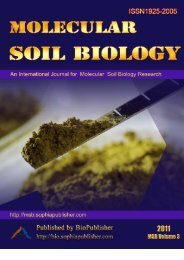Molecular Plant Breeding (online), 2011, Vol. 2 http://mpb ...
Molecular Plant Breeding (online), 2011, Vol. 2 http://mpb ...
Molecular Plant Breeding (online), 2011, Vol. 2 http://mpb ...
- No tags were found...
You also want an ePaper? Increase the reach of your titles
YUMPU automatically turns print PDFs into web optimized ePapers that Google loves.
Research Letter<strong>Molecular</strong> <strong>Plant</strong> <strong>Breeding</strong> <strong>2011</strong>, <strong>Vol</strong>.2, No.08, 48-59<strong>http</strong>://<strong>mpb</strong>.sophiapublisher.comOpen AccessIntegration and Expression Stability of Transgenes in Hybriding Transmissionof Transgenic Rice <strong>Plant</strong>s Produced by Particle BombardmentYan Zhao 1,2 , Longbiao Guo 2 , Huizhong Wang 3 , Danian Huang 21. College of Food Science and Biotechnology Engineering, Zhejiang Gongshang University, Hangzhou, 310035, P.R. China2. State Key Laboratory of Rice Biology, China National Rice Research Institute, Hangzhou, 310006, P.R. China;3. College of Life and Environmental Science, Hangzhou Normal University, Hangzhou, 310018, P.R. ChinaCorresponding author email: yanzhao9918@163.com; Author<strong>Molecular</strong> <strong>Plant</strong> <strong>Breeding</strong>, <strong>2011</strong>, <strong>Vol</strong>.2 No.08 doi: 10.5376/<strong>mpb</strong>.<strong>2011</strong>.02.0008Received: 26, Apr., <strong>2011</strong>Accepted: 14, Jun., <strong>2011</strong>Published: 20, Jun., <strong>2011</strong>This is an open access article published under the terms of the Creative Commons Attribution License, which permits unrestricted use, distribution, andreproduction in any medium, provided the original work is properly cited.Preferred citation for this article:Zhao et al., <strong>2011</strong>, Integration and Expression Stability of Transgenes in Hybriding Transmission of Transgenic Rice <strong>Plant</strong>s Produced by Particle Bombardment,<strong>Molecular</strong> <strong>Plant</strong> <strong>Breeding</strong> <strong>Vol</strong>.2 No.08 (doi: 10.5376/<strong>mpb</strong>.<strong>2011</strong>.02.0008)Abstract Four transgenic rice lines TR 5, TR 6, Ming B and Jingyin 119 obtained via particle bombardment were used as transgenedonors to create hybrids. The integration and expression stability of exotic bar and cecropin B gene in conventional hybridingtransmission were investigated by Southern and Northern blotting analyses. The selection marker bar gene was transferred to allhybrids under selection of Basta herbicide. Loss or gain of small hybridization bands (no more than 2.0 kb) of bar gene occurred insome hybrids, but the difference in integration sites of bar gene copies did not influence their stable expression. The non-selectiongene cecropin B was stably transferred from the four transgene donors to their resulting hybrids, but expression level was verydifferent. Silencing of cecropin B gene occurred in some hybrids from TR 5, TR 6 and Ming B. In the transgene donor Jingyin 119and all its resulting hybrids, cecropin B and bar gene were stably expressed. We concluded that the stability of transgene duringcrossbreeding transmission is mainly determined by the primary transgenic donors and may be affected by recombination.Keywords Transgene; Heredity and expression; Hybriding transmission; Particle bombardment; RiceBackgroundRice is the world’s most important food crop and aprimary source of food for more than half the world’spopulation (Khush, 2005). Improvements in crop yieldhave been achieved through conventional hybridizationand selection procedures (Peng et al., 2007). Currently,rice hybrids are cultivated in about 55% of therice-growing areas in China and contribute to 66% ofthe total rice production of the whole country (Wu andLuo, 2007). The breakthrough in plant biotechnologyhas provided tools to develop more elite transgenicdonors for crop crossbreeding. In the transformationprocess, ideally, a single gene with its appropriatecontrolling elements is added to the genome instead ofmoving a whole chromosome or chromosomesegment with many known and unknown genes asdone with the traditional hybridizations (Horvath et al.,2001). Since protocols for rice transformation havebeen well established, genetic transformation iscurrently complementing conventional breedingprograms in the development of advanced germplasm(Popelka and Altpeter, 2003). In 1996, the herbicideresistantbar gene was transformed into Japonica riceJingyin 119 via particle bombardment (Huang et al.,1996), and then the transgenic plants weresuccessfully crossed to the male-sterile line Pei-ai 64Sof a two-line crossbreeding system for creatingtransgenic rice hybrids. Based on the herbicideresistance of the marker gene bar, a new method wascreated to examine and improve the purity of hybridrice (Huang et al., 1998). More recently, Chen et al.introduced the synthetic cryl2A* and crylC* gene intoan elite Indica cytoplasm male-sterile restorer lineMinghui 63 and crossed the transgenic lines toZhenshan 97A to produce insect-resistant hybrid rice(Chen et al., 2005; Tang and Lin, 2007). Transgenictechnology is providing new tools for the conventionalcrossbreeding of rice.The main methods used for rice transformation areparticle bombardment and Agrobacterium-mediated48






